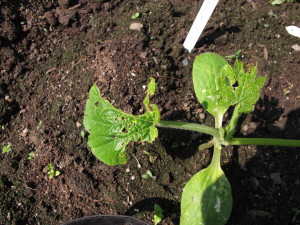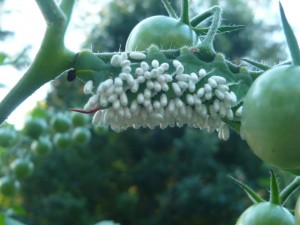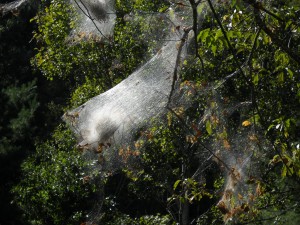Dealing with Pests and Diseases
I understand why many gardeners shop on Death Row. That’s what I call the pesticide aisle at the garden center. Insecticides, fungicides, herbicides are sold in cheerful colorful bags, often with pictures of blooming flowers on the bag. I don’t shop there and try to avoid even walking down the aisle because the smell of death – poison – is often in the air.
Gardeners shop on Death Row because something is threatening their roses or their broccoli. Flea beetles making holes in the cabbage? Nuke ‘em. Japanese beetles? Gotta kill ‘em. I get the urge, too. But there are alternatives.
Let’s start with something easy: I drape a light-weight gauzy film of agricultural fabric over plants to keep bugs from physically getting to my plants. This cloth allows sun and rain to pass through, but not bugs. It’s called row cover or by trade names like Reemay and Agribon. There are other brand names, too.
Row cover comes in different weights, and some heavier types can be used to keep in a little heat at night, holding off frost. But its best use is to keep plants bug-free. I use it over my vine crops like cucumbers and squash as they are very vulnerable to a pest called the striped cucumber beetle.
Row cover is not perfect: striped cucumber beetles live in the soil, and sometimes will appear under the row cover, but mostly it prevents them from getting to the plants. To be on the safe side, I start cukes and squash inside the house 3 weeks or more before planting time (or buy a 6-pack of starts). That gives me good-sized plants that can survive some beetle attack.
Generally I just drape the row cover over the cucumber plants and pin down the edges with special staples sold for the purpose. It is light enough that it will just float on top. But since vine crops are insect pollinated, I need to take it off once the plants start to bloom.
Hoops are sold to support row cover, too. Five foot sections of #10 wire are sold for the purpose. Just poke one end into the soil, bend it, and poke in the other end. This is great for keeping flea beetles and cabbage moths of broccoli, cabbage and related plants.
Repellents can help to keep insects off plants. Liquid fish fertilizer has worked for me to reduce the number of Japanese beetles on roses and other decorative plants, though I wouldn’t use it on vegetables. Garlic Barrier is product made from garlic and citric acid that can be diluted and spread on plants to repel insects. It is rated for use on vegetables, and has no flavor once it has dried. In any case, you must get the repellents sprayed before the insects show up, and need to re-apply regularly. It is fine for use by organic gardeners.
Traps sound good, but generally are not. Japanese beetle traps use a sex hormone to attract the beetles, but unfortunately they attract many more beetles than they catch. And those pesky beetles like to have a snack before investigating the scent of sex. Give them to your neighbors, perhaps, but don’t use them!
Hand-picking bugs really does work, particularly if you are diligent when they first appear. Pick potato beetles every day as soon as you see them (or their larvae). Look under the leaves for orange egg masses, too. Don’t let a second generation get started! Get them early, and avoid trouble later on.
Keep these points in mind if you want have a good garden and healthy plants:
1) Healthy plants growing in favorable conditions (such as the right amount of sun, and moisture in the soil) are less susceptible to diseases.
2) Select disease-resistant cultivars when possible. Modern hybrids are often bred for disease resistance.
3) Don’t over-fertilize. Too much nitrogen gives fast green growth, but promotes weak tissue that is more susceptible to diseases.
4) Try to keep leaves dry when watering. Moisture on leaves, particularly at night, helps some fungal diseases to get established. A hand-held watering wand can direct water to the roots; overhead sprinklers get everything wet.
5) Prune off diseased leaves and dispose of them in the trash. Never let diseased plants over-winter in the garden. Keep your garden clean. Clean up in fall and spring to remove diseased plant matter.
6) Lastly, don’t overreact. Most fungal diseases won’t kill a healthy plant that is well planted in good soil. Don’t rush to spray chemicals. Once a leaf is infected, you can’t fix it, only live with it or cut it off.
As an organic gardener I accept that sometimes bugs or diseases win. I no longer grow Oriental or Asiatic lilies because of a beautiful red beetle that attacks them. I can’t control the pest by hand picking. That’s okay, I grow angel’s trumpet (Datura spp.), a lily-like flower that is even better – it blooms for many weeks with gorgeous big white flowers). And it doesn’t need chemical poisons to thrive.
Read my blog twice weekly at www.dailyUV.com. You can sign up to get the blog post sent to you be email.
Tomato Hornworms and Other Late Summer Pests
Sometimes it’s easy to get discouraged about the garden: Early in the spring there are seeds that don’t germinate well in cold, wet soil. Then the weeds germinate too well and try to take over the garden when things warm up. Next Colorado potato beetles attack the potatoes. By mid-summer early blight and other diseases start killing leaves and slowing growth on tomatoes, and now the tomato hornworms come along to browse the tomatoes and their vines. Gee whiz, is there no mercy for gardeners? I thought gardening was supposed to be easy!
But there is some good news. Mother Nature is doing her best to control some pests, tomato hornworms among them. Tomato hornworms are green larvae that get huge (up to 3-5 inches long), and have voracious appetites. Bad infestations can defoliate tomato plants in just a day or two. Because of their green color and markings, they are often very hard to notice, too. This year they seem worse than normal, according to some of my readers – though not in my garden. This is the season when they are most prevalent.
If you seen a tomato hornworm with little white attachments something like small grains of uncooked rice, do not kill the hornworm as it is being attacked by the larvae of a parasitic wasp. These white projections are cocoons containing the pupae of a braconid wasp. They indicate that the good bugs have found the bad bugs, and will destroy them.
I watched a hornworm that was covered with these tiny white cocoons, and over a 24 hour period it ate nothing. It was slowly dying, and appeared to have no appetite. I called Dr. Alan Eaton, NH State Entomologist, who told me that the wasps kill their prey slowly, allowing the larvae to feed long enough to develop. At a certain point, he said, the hornworms stop feeding. When he encounters a hornworm with parasitic wasp cocoons, he takes no chances – he moves it to another location away from his tomatoes where the braconid wasps can develop.
If you’ve seen a moth that resembles a hummingbird, that is the adult form of the tomato hornworm. According to Dr. Eaton, an adult moth of the tomato hornworm is about the same size as a ruby throated hummingbird. They are very strong fliers, and actually overwinter in the places where they can survive without freezing. Then they fly north in the spring, finding new feeding and mating territories.
One last hornworm tidbit: according to Dr. Eaton, there are 2 species, the tomato hornworm and the tobacco hornworm, and the tobacco hornworm is much more prevalent. So if you have been cussing out those nasty tomato hornworms, maybe they’re laughing and saying, “We’re actually tobacco hornworms!”
According to Dr. Eaton – and several readers who have sent me questions – this is a bad year for green stinkbugs. These triangular-shaped green bugs are feeding on everything from grasses and veggies to peaches and apples. Perhaps the mild winter resulted in higher numbers of them. They stink if crushed, so Dr. Eaton recommends picking them and dropping them into soapy water. The brown marmorated stinkbug is often a pest, but the green one is not usually as prevalent as it is this year.
This is also the season that fall webworms appear. You may call them tent caterpillars, but they are of a different species of pest. The tent caterpillars form webs, or tents in crotches of trees early in the summer, but the webworms create their nests near the tips of branches now, and into the fall. With time, the nests get bigger, enclosing more and more leaves as they grow. If the tent is down low you can physically remove the teeming mass of caterpillars by clipping off the branch and dropping it into a bucket of soapy water.
If the fall webworms are close enough to the ground that you can spray the leaves near them, you can apply a biological control. There is a product called Dipel, which contains a bacterium (Bt kurstaki) that will kill the worms if they eat leaves sprayed with it. This bacterium will not hurt us, our pets, fish or birds. It is specific to caterpillars. And Dipel lasts for years in the container, so you can invest in a package of it and know that it will be good in the future.
I understand the urge to “nuke” the bad bugs. Hornworms eating my tomatoes? Nuke ‘em. But I don’t. And since I let the braconid wasps feed on the hornworms years ago, I rarely see one of those bad boys. Chemical pesticides change the garden environment. It may please you in the short run, but in the long run, let Mother Nature – and your fingers – take control. Pick’em, don’t nuke ‘em.
Henry Homeyer’s new children’s book, a fantasy-adventure for 8-12 year-olds called Wobar and the Quest for the Magic Calumet, is coming out in October. His Web site is www.Gardening-Guy.com; his e-mail is henry.homeyer@comcast.net.






